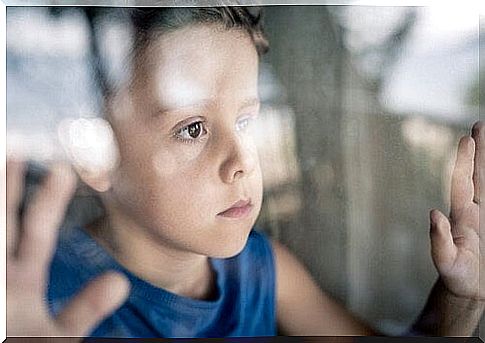Childhood Disintegrative Disorder

Also known as Heller’s syndrome, childhood dementia, or symbiotic psychosis, childhood disintegrative disorder is a very rare disease. It affects children aged 2 to 10, causing a significant loss of already acquired skills.
In DSM-IV this syndrome was included in the category of pervasive developmental disorders along with autism, Rett’s and Asperger’s syndrome. In the fifth edition, however, childhood disintegrative disorder disappears as an independent diagnosis. It is diagnosed only if the criteria for autism spectrum disorder are also met as “autism spectrum disorder associated with a known medical condition”.
In this article, we present the symptoms and causes of this disorder, how it is diagnosed and which treatments have proven effective.

A bit of history
In 1905, Sante De Sanctis (1862-1953), physician, psychologist and psychiatrist from Lazio, described a picture similar to childhood disintegrative disorder. He therefore created the category dementia praecocissima , including various disorders that cause mental retardation.
A few years later, in 1908, the Austrian educator Theodor Heller described some cases of disintegrative psychosis, a disorder that began around four years of age after normal development. The author is called Heller’s Syndrome.
Finally, Margaret Mahler spoke of symbiotic psychosis. The Hungarian psychoanalyst stressed the importance of two constitutional factors in a form of infantile psychosis that manifested itself between the ages of three and six, which she called symbiotic psychosis.
Diagnosis of childhood disintegrative disorder
DSM-V eliminated this disorder as it is a medical condition. Nonetheless, autism spectrum disorder has the “associated with a known medical condition” specifier. This makes it possible to diagnose autism spectrum disorder (if the diagnostic criteria are met) along with childhood disintegrative disorder.
The previous edition, the DSM-IV-TR, reported the diagnostic criteria for this disorder. In the first years of life there is an apparently normal development with communication skills, social relationships, play and adaptive behavior typical of age.
From the age of two and before the age of ten, however, important losses of the skills already acquired begin to occur, in at least two of the following areas:
- Expressive and receptive language.
- Social ability or adaptive behavior.
- Bowel or bladder control.
- Game.
- Motor skills.
In addition, there must be an alteration in two of the following areas, which coincide with the typical alterations of autism: qualitative alteration of social interactions and communication or patterns of behavior, interests and repetitive and stereotyped activities.
Finally, in order to diagnose childhood disintegrative disorder, these symptoms need not be justified by the presence of other pervasive developmental disorders or by schizophrenia. This is an essential condition.
Symptoms of childhood disintegrative disorder
- Loss of language skills. The acquired words and the ability to communicate are lost, including the receptive capacity.
- Difficulty in social relationships and adaptive behavior. Reduced interaction with classmates and family members leads the child to become isolated. This is induced by a complete lack of interest in the surrounding environment.
- Loss of motor skills. The child has difficulties with gross motor skills such as running (or walking in severe cases). This is accompanied by obvious difficulties in fine motor skills (picking up objects or joining fingers).
- Loss of sphincter control. The child gains bowel and bladder control between the ages of two and four. Childhood disintegrative disorder causes the loss of this ability.
- Qualitative alteration of social interactions. It can manifest itself with a deficit of non-verbal communication, an inability to establish social relationships, an absence of social or emotional reciprocity, etc.
- Stereotyped behavior and limited interests such as inflexible adherence to certain routines, intolerance to changes, motor mannerisms and stereotypies, strange interests (e.g. interest in the edges of objects instead of the object as a whole).

Causes
The etiology, or origin, of childhood integrative disorder is not entirely clear. The precise mechanisms that cause it have not yet been discovered. Possible causes include lesions of the central nervous system during the development and appearance of a neurological disease, such as tuberous sclerosis. At the moment, however, there is no firm evidence.
As we have observed, childhood disintegrative disorder is very rare (by the way, more common in boys) and, unfortunately, has no cure. However, it is possible to follow treatments aimed at improving the quality of life and preserving the skills already acquired.
Areas of intervention
The intervention is generally multidisciplinary and extends to the following aspects:
- Pharmacotherapy. It can help reduce stereotypical behaviors (which in many cases can be self-damaging) and the symptoms of other concomitant disorders.
- Nutritional therapy. It ensures the supply of nutrients, as the child often has difficulty chewing and swallowing food.
- Behavioral therapy. Helps reduce unwanted behaviors, such as stereotypies, and improve retained skills. In some cases, a lost skill can be recovered.
- Alternative therapies, which usually accompany medical and behavioral treatment. The music therapy or horse therapy are often used because they have proven their usefulness in these cases and in other neurodevelopmental disorders.
By definition, these symptoms appear between 2 and 10 years, in a sudden or insidious way and can be accompanied by prodromal manifestations such as short temper, hyperactivity, anxiety and minor losses of some abilities.
As a result of the stabilization of the disorder, some small improvement may occur. However, social, communication and behavioral deficits are constant and stable throughout life. Any treatment that offers an improvement, however small it may be, in terms of symptoms and quality of life is certainly positive.









